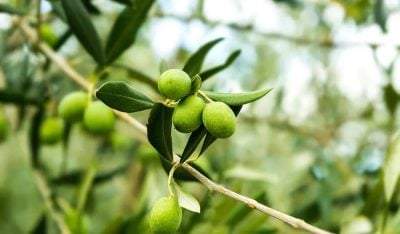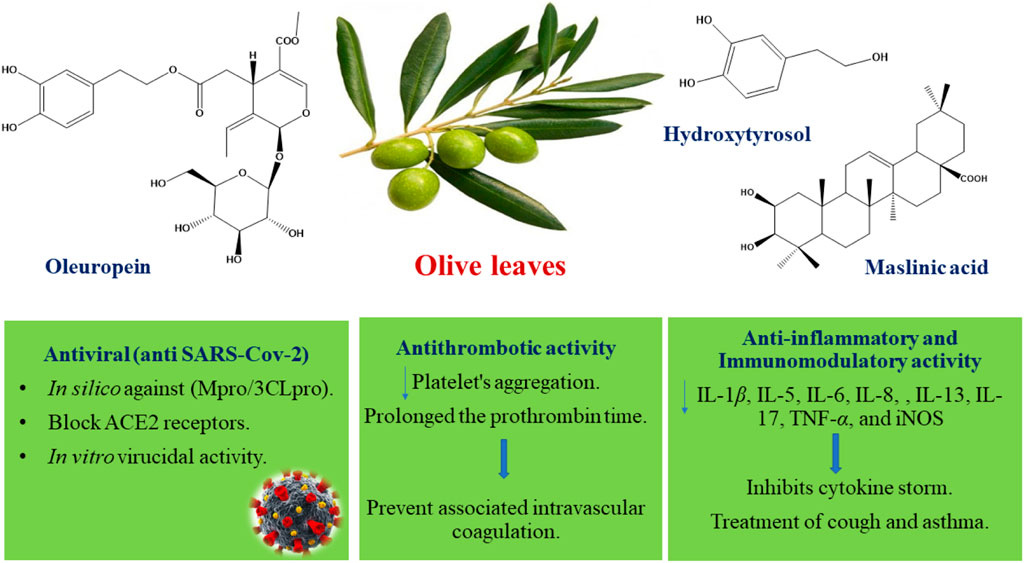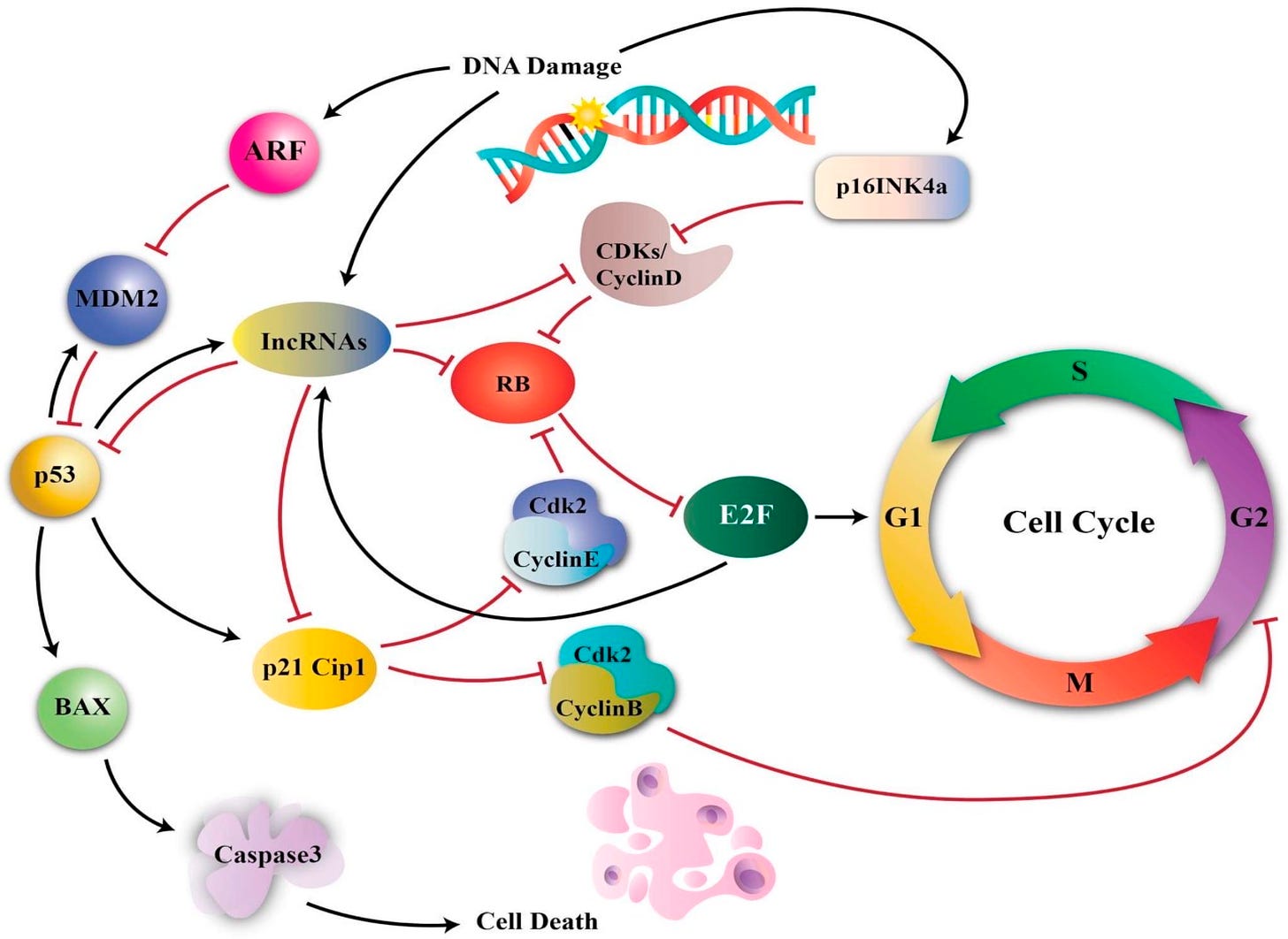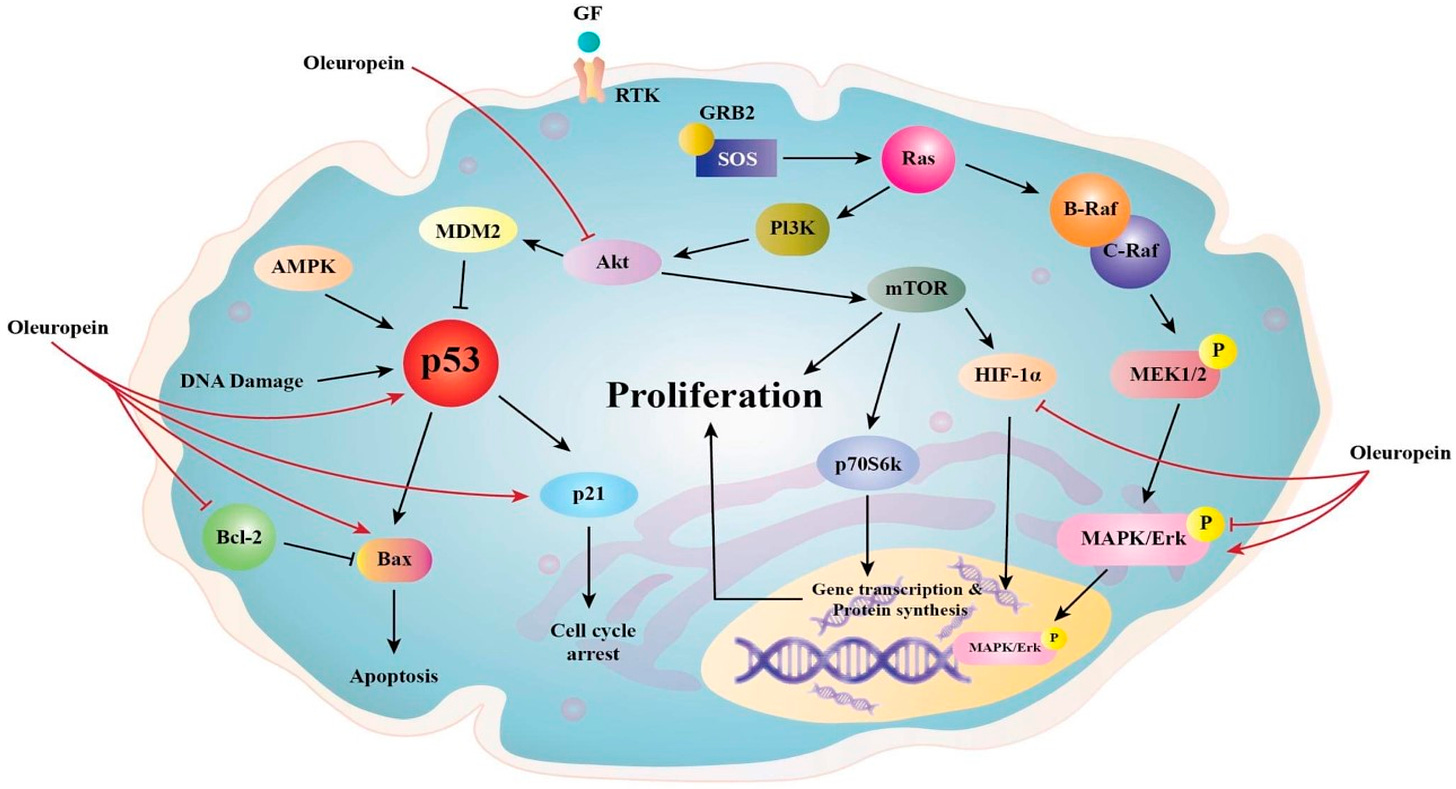New Research on Olive Leaf Extract and Cancer

All Global Research articles can be read in 51 languages by activating the Translate Website button below the author’s name (only available in desktop version).
To receive Global Research’s Daily Newsletter (selected articles), click here.
Click the share button above to email/forward this article to your friends and colleagues. Follow us on Instagram and Twitter and subscribe to our Telegram Channel. Feel free to repost and share widely Global Research articles.
Global Research Referral Drive: Our Readers Are Our Lifeline
***
New Literature:
-
(2022 July, Rishmawi et al) – A Comprehensive Review on the Anti-Cancer Effects of Oleuropein
- (2023 Sep, Karousi et al) – Next-generation sequencing reveals altered gene expression and enriched pathways in triple-negative breast cancer cells treated with oleuropein and oleocanthal
- (2024 Jan, Nsairat et al) – Oleuropein impact on colorectal cancer
-
(2024 Feb, Gervasi et al) – Use of Oleuropein and Hydroxytyrosol for Cancer Prevention and Treatment: Considerations about How Bioavailability and Metabolism Impact Their Adoption in Clinical Routine
Introduction
- Olive Leaf raw dried leaves
- Olive Leaf (whole) (supplement)
- Olive Leaf Extract 6% Oleuropein
- Olive Leaf Extract 15%, 20% or 25% Oleuropein
- Olive Leaf Extract liquid drops

Rich in Phenolic Compounds
Olive is a small tree native to Asia whose domestication is believed to have taken place at the Turkey / Syria border 8000 years ago, and spread throughout the Mediterranean, Europe, Iran and Northern Africa. (Click here)
There are ~ 890 million olive trees in the world and 172 million of them are in Turkey. During the harvesting of olives together with pruning stages, considerable amount of by-product mainly consisting of olive leaves are accumulated, ~ 25 kg per tree. This biomass is generally used to feed animals. (Click here)
Olive trees are predominantly grown in the Mediterranean region, characterized by extended periods of sunlight and high rates of pathogen and insect attack. To combat these stressors, olive trees synthesize large volumes of polyphenols, which are largely stored in their thick leaves. (Click here)
Olive leaf (Olea europaea) extracts have been regarded as valuable items since ancient times. It is known that pharaohs were mummified using olive leaf extracts by Egyptians. In the next years, olive leaf extracts were used for health purposes such as healing fevers, and healing tropical diseases such as malaria. (Click here)
Olive leaves are rich in phenolic compounds such as oleuropein, hydroxytyrosol, verbascoside, apigenin-7-O-glucoside, and luteolin-7-O-glucoside and also triterpenoids such as maslinic, ursolic, and oleanolic acids that have been reported as anti–SARS-CoV-2 metabolites. (Click here)
Olive leaves have been reported to have biological activities such as: antioxidant, anti-inflammatory, anti-hypertensive, anti-hypercholesterolemic, cardioprotective, anti-obesity and anti-cancer. (Click here)
*
- Oleuropein is one of the primary elements in immature olive fruits and leaves
- Oleuropein consumption has aided in cancer treatment as an antioxidant
- It is now known that Oleuropein functions as both an anti-proliferative and an apoptotic promoter in many cancer cells
- has been shows to decrease proliferation of breast cancer cells in vitro
- anti-proliferative effects by inhibiting NF-kB pathway, Akt Cascade
- colon cancer: proliferation and angiogenesis is propmoted by COX2 pathway which is downregulared by Oleuropein
- anti-metastatic effect by inhibiting activity of matrix metalloproteinases (which promote tumor metastasis)
- APOPTOSIS: Oleuropein raises the expression of the proapoptotic proteins p53 and Bax while decreasing the expression of the antiapoptotic proteins Bcl-2 and HIF-1 (gliomas, pancreatic cancer, breast cancer)
- Oleuropein upregulates Cannabinoid Receptor CB1 (tumor suppressor) – activation of this receptor initiates many cascades that prevent cancer onset, progression, and proliferation due to diverse mechanisms in multiple cancer cells, such as GI, lung, breast, and brain, prostate, pancreas, and thyroid.
- anti-angiogenic effect in vivo breast cancer cell lines (lowers VEGF – vascular endothelial growth factor)
- anti-oxidant effects – antioxidant properties stem from its capacity to chelate metal ions such as copper and iron, which catalyze free radical production reactions, as well as its ability to inhibit several inflammatory enzymes
- Copper is a vital nutrient in the body, acting as a cofactor in a wide range of enzymatic operations as well as a structural component of proteins.
- Copper dysregulation or increase has been associated with lymphoma; reticulum cell sarcoma; bronchogenic and laryngeal squamous cell carcinomas; and cervical, breast, stomach, and lung cancers
- one study suggests Oleuropein complexing with copper is responsible for its ability to kill cancerous tissue (2017, Capo et al)
- cancer cell viability – Oleuropein reduces cell viability in breast cancer cells, pancreatic cancer cells and seminoma cells.
- cell cycle arrest – Oleuropein upregulates p53 and p21 and causes cell cycle arrest


- cytoskeleton disruptor – Oleuropein disrupts actin filaments in cytoskeleton of breast cancer cells and ovarian cancer cells
- Fatty acid synthase inhibitor – Oleuropein inhibits fatty acid synthase enzyme which is overexpressed in many cancers (prostate, ovarian, breast, endometrial, thyroid, colorectal, bladder, lung, thyroid, oral, tongue, esophageal, hepatocellular, pancreatic, and gastric carcinomas; malignant melanoma; mesothelioma; nephroblastoma; and retinoblastoma; as well as soft tissue sarcoma)
- Conclusion:
- “Oleuropein has aided in cancer treatment over the years. Ole functions as an anti-cancer agent by having anti-proliferative, anti-angiogenic and apoptotic, antioxidant, fatty acid synthase inhibiting, cytoskeleton disrupting, and anti-inflammatory properties. Oleuropein effects on cancer cells are influenced by Ole concentration, exposure time, and cancer cell type. Ole has strong synergistic effects when combined with anticancer medicines such as doxorubicin and other. Ole is a prospective anticancer candidate that could be utilized as a supplement to existing anticancer therapy guidelines or as a recurrence prevention therapy.”
- Triple-negative breast cancer (TNBC) is a subtype of breast cancer characterized by poor prognosis and limited treatment options.
- Oleuropein and oleocanthal considerably reduced the proliferation of TNBC cells
- expression profile of TNBC cells was significantly altered after treatment with these compounds
- Pathway analysis revealed several significant pathways associated with TNBC, including cell death, apoptotic process, programmed cell death, response to stress, mitotic cell cycle process, cell division, and cancer progression
- Conclusion: “Our findings suggest that oleuropein and oleocanthal have potential therapeutic benefits for TNBC and can be further investigated as alternative treatment options.”
- The Mediterranean Diet (MD) is associated with a low incidence of CRC (colorectal cancer) and Olive Oil is a main component of the diet
- The olive (Olea europaea) tree’s leaf and fruit, as well as the extra virgin olive oil, are rich sources of oleuropein (OLR). OLR is nonflavonoid biophenol.
- OLR inhibits cell proliferation – OLR inhibits NF-κB and its downstream targets cyclin D1 and cyclooxygenase-2 (COX2)
- COX2 pathway is connected to CRC because it promotes proliferation and angiogenesis via increased prostaglandin production. OLR was demonstrated to downregulate COX2
- OLR caused apoptosis in colon tumors
- Additionally, OLR prevented CRC progression through upregulation of the gene coding for cannabinoid receptors (CB)
- IN VIVO STUDIES:
- mice studies with OLR supplemented showed decreased number of colon tumors, decreased tumor size, inhibition of growth of cancer cells, decreased inflammation
- OLR also prevented CRC and DNA damage in mice treated with a carcinogen.
- High concentrations of OLR administered in vivo were demonstrated to be safe, and studies on rodents showed that it had an excellent safety profile
- Conclusion: “OLR is a good candidate that could be used as a supplement along with anticancer therapy as a preventive therapy. Due to the extraordinary therapeutic and preventive effect of OLR, we need to further exploit this key Mediterranean dietary component to promote human health.”
2024 Feb, Gervasi et al – Use of Oleuropein and Hydroxytyrosol for Cancer Prevention and Treatment: Considerations about How Bioavailability and Metabolism Impact Their Adoption in Clinical Routine
- Animal studies done on mice:
- breast cancer (50mg/kg) – decrease in tumor size, decrease in proliferation, induction of apoptosis, increase in levels of tumor suppressor p21
- colorectal cancer (50 and 100mg/kg) – reduced incidence of colonic neoplasms, reduced cancer cell proliferation
- pancreatic cancer (200mg/kg HT – Hydroxytyrosol x 10- days) – suppressed tumor growth and proliferation
- cholangiocarcinoma (500mg/kg peritoneal injection) – reduced tumor growth
- melanoma (25mg/kg) – effective in preventing skin carcinogenesis, effective in prevention of melanoma growth and metastasis
- Animal studies done on Oleuropein and chemo damage:
- in vivo, 50 mg/kg, 100 mg/kg, and 200 mg/kg OLE showed a dose-dependent antioxidant activity, accounting for amelioration of cisplatin-induced pancreatic, liver, lung, and stomach damage in Spraque–Dawley rats
- In the same in vivo model of cisplatin-induced oxidative stress, 50 mg/kg, 100 mg/kg, and 200 mg/kg OLE improved anemia, thrombocytopenia, and leukopenia
- treatment of BALB/cN mice with 5, 10, and 20 mg/kg OLE suppressed signs of cisplatin-induced renal inflammation
- Conclusion: “the multifaceted nature of OLE and HT interaction with molecular mediators in cancer cells and non-cancer tissues determines the need for safe strategies to improve OLE and HT bioavailability and delivery, also offering a more stable and highly selective anti-proliferative activity throughout time.”
My Take…
A clinical trial was done in Iran with Olive Leaf Extract (30% Oleuropein) and COVID-19 patients, and was published in Aug.2023. It showed:
“Olive Leaf Extract effectively reduced respiratory rate, pulse rate, and body temperature; and increased blood oxygen saturation of COVID-19 patients. It decreased ESR and CRP levels in COVID-19 patients. Also, the findings showed that olive leaf extract can shorten the duration of hospitalization and lead to the early discharge of the patient. Moreover, there was no difference between the two doses of olive leaf extract (250 mg and 500 mg) in terms of efficacy.”
“Previous studies revealed that oleuropein, a secoiridoid, is a potent antiviral agent against HIV and influenza. A molecular study revealed that olive secoiridoids could interfere with the entry and replication of SARS-CoV-2. Olive secoiridoids block the spike protein of SARS-CoV-2, which facilitates virus entry by binding to ACE-2 receptors. Also, olive secoiridoids inhibit the main protease of SARS-CoV-2, a critical mediator in virus replication. Moreover, olive secoiridoids can suppress inflammation by targeting receptors of pro-inflammatory cytokines (IL-1β, IL-6, TNF-α). Many of the deaths in COVID-19 patients occurred following a cytokine storm. Olive leaf extract could act as an anti-inflammatory drug, suppress inflammatory storms, and decrease mortality.”
From a very recent study by Wafik El-Deiry:
“The suppressive effect of SARS-CoV-2 spike on p53-dependent gene activation provides a potential molecular mechanism…may impact tumorigenesis, tumor progression and chemotherapy sensitivity”
To summarize the benefits of olive leaf extract:
- Binds the SARS-CoV-2 spike protein (can be used to treat COVID-19 mRNA Vaccine Injury, shedding, Long COVID and acute COVID-19 Infection)
- Potent antiviral against coronaviruses, Influenza, RSV and even HIV
- Upregulates expression of p53 tumor suppressor protein in cancers“p53 is the most frequently mutated gene in cancer, but even more importantly, it is particularly mutated in some of the most aggressive cancers we currently have, for example triple-negative breast cancer, ovarian cancer, etc”
- Potent anti-cancer agent: “Oleuropein has aided in cancer treatment over the years. Ole functions as an anti-cancer agent by having anti-proliferative, anti-angiogenic and apoptotic, antioxidant, fatty acid synthase inhibiting, cytoskeleton disrupting, and anti-inflammatory properties. Ole has strong synergistic effects when combined with chemotherapy. Ole is a prospective anticancer candidate that could be utilized as a supplement to existing anticancer therapy guidelines or as a recurrence prevention therapy.”
- Animal models are very promising in breast cancer, colon cancer, pancreatic cancer, melanoma, cholangiocarcinoma
*
Note to readers: Please click the share button above. Follow us on Instagram and Twitter and subscribe to our Telegram Channel. Feel free to repost and share widely Global Research articles.
Dr. William Makis is a Canadian physician with expertise in Radiology, Oncology and Immunology. Governor General’s Medal, University of Toronto Scholar. Author of 100+ peer-reviewed medical publications.


